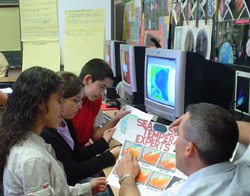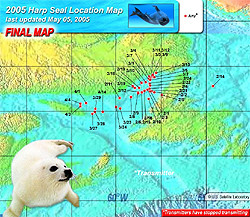Feature
Turtles, Dolphins and Seals, Oh My!
05.23.05
| Who Are NASA's Earth Explorers? The elementary school student questioning if El Niño occurs anywhere besides the Pacific Ocean. The researcher investigating connections between Arctic ozone depletion and global climate change. The citizen scientist interested in how changing land cover and use affects animal migration patterns. And the businessperson projecting future needs for harvest, delivery and storage of crops. All of these people are Earth Explorers -- they are all connected by their curiosity about Earth system processes. This monthly series will introduce you to NASA Earth Explorers, young and old, with a variety of backgrounds and interests. Nominate an Earth Explorer! Tell us about the Earth Explorers you know. We're looking for students, teachers, scientists and others who are working with NASA Earth science data and imagery to better understand our home planet. Send your nominations to Dan Stillman: dan_stillman@strategies.org. |

|
Image to left: Harp seals and other types of marine and land species are tracked by satellite. Students combine location data and other information to predict and explain where and how quickly animals move. Credit: Signals of Spring
No, Arty is not a TV show character or the latest craze in talking stuffed animals. He is a harp seal making his way through the Gulf of St. Lawrence, and students at hundreds of schools across the country can't get enough of him.
The seventh- and eighth-graders at Ann Street School in Newark, N.J., are no exception. Through the NASA-sponsored Signals of Spring program, they're able to stay hot on the trail of harp seals and many other marine and land species tagged with small satellite transmitters. Students track the migrating animals using interactive online maps.

|
"It's an application of science and technology," she said.
Image to right: Students used many different types of maps to predict the migration of marine and land animals. Credit: Signals of Spring
Students predict and explain the movement of animals by combining location data with maps of topography, vegetation, sea-surface temperature and other variables. Then they present their work in a variety of formats, including research papers, children's books, videos and skits.
"Each kid is allowed to pursue his [or her] own creativity," said Manny Oliveira, an eighth-grade science teacher at Ann Street.
Signals of Spring made its Ann Street debut in 2000 as a program for gifted and talented students, but was quickly expanded to include the entire seventh and eighth grades. The educational content addresses state and local standards in the Earth and life sciences, math, geography and technology.
"It was so good, and such a terrific turn on for science and technology and all the other disciplines that are interrelated, that we felt that we wanted to share it with every student," said Salgueiro, who, along with Principal Joseph Maccia, oversees incorporation of the program into the school's curriculum.
Each year the seventh-grade class precedes its Signals of Spring work with a field trip to a nearby eagle festival. The students cruise the Connecticut River on a research boat looking for bald eagles in their natural habitat. Salgueiro says the annual outing brings to life the animals that the students later track over the computer.

|
Image to left: This map shows where Arty the harp seal has traveled. Credit: Signals of Spring
Once the Signals of Spring animals -- seals, eagles, turtles, dolphins, swans and more -- begin their spring migration, students are divided into teams, with each team focusing on a different factor that might affect an animal's movement. Weather, vegetation, phytoplankton, bathymetry (topography of the ocean floor) and other elements of the environment can influence the direction and speed of a migrating animal.
In addition to explaining their findings in front of the class, Ann Street students have presented their work to scientists, school teachers and administrators, environmental organizations, and at conferences and workshops. Also, students at the school have entered their Signals of Spring projects into the NASA Student Involvement Program and twice won the competition's top prize.
According to Oliveira, the greatest reward for students is the sense of accomplishment they feel from doing real science.
"They can see that, 'Hey... I'm doing what a meteorologist is doing on TV -- predicting what's going to happen tomorrow," he said. "They feel, 'Wow, you don't need to be [an adult] to do this.'"
See previous Earth Explorers articles:
+ View site
Related Resources
Signals of Spring
+ View site
The Space Place: Migration Concentration
+ View site